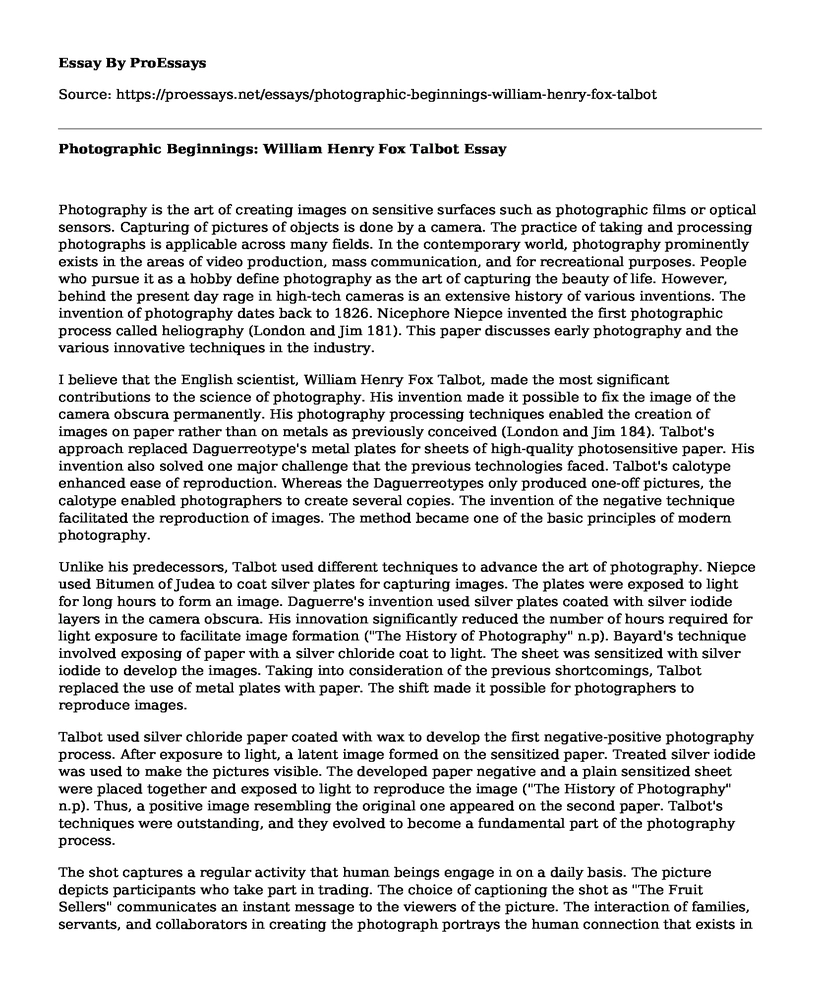Photography is the art of creating images on sensitive surfaces such as photographic films or optical sensors. Capturing of pictures of objects is done by a camera. The practice of taking and processing photographs is applicable across many fields. In the contemporary world, photography prominently exists in the areas of video production, mass communication, and for recreational purposes. People who pursue it as a hobby define photography as the art of capturing the beauty of life. However, behind the present day rage in high-tech cameras is an extensive history of various inventions. The invention of photography dates back to 1826. Nicephore Niepce invented the first photographic process called heliography (London and Jim 181). This paper discusses early photography and the various innovative techniques in the industry.
I believe that the English scientist, William Henry Fox Talbot, made the most significant contributions to the science of photography. His invention made it possible to fix the image of the camera obscura permanently. His photography processing techniques enabled the creation of images on paper rather than on metals as previously conceived (London and Jim 184). Talbot's approach replaced Daguerreotype's metal plates for sheets of high-quality photosensitive paper. His invention also solved one major challenge that the previous technologies faced. Talbot's calotype enhanced ease of reproduction. Whereas the Daguerreotypes only produced one-off pictures, the calotype enabled photographers to create several copies. The invention of the negative technique facilitated the reproduction of images. The method became one of the basic principles of modern photography.
Unlike his predecessors, Talbot used different techniques to advance the art of photography. Niepce used Bitumen of Judea to coat silver plates for capturing images. The plates were exposed to light for long hours to form an image. Daguerre's invention used silver plates coated with silver iodide layers in the camera obscura. His innovation significantly reduced the number of hours required for light exposure to facilitate image formation ("The History of Photography" n.p). Bayard's technique involved exposing of paper with a silver chloride coat to light. The sheet was sensitized with silver iodide to develop the images. Taking into consideration of the previous shortcomings, Talbot replaced the use of metal plates with paper. The shift made it possible for photographers to reproduce images.
Talbot used silver chloride paper coated with wax to develop the first negative-positive photography process. After exposure to light, a latent image formed on the sensitized paper. Treated silver iodide was used to make the pictures visible. The developed paper negative and a plain sensitized sheet were placed together and exposed to light to reproduce the image ("The History of Photography" n.p). Thus, a positive image resembling the original one appeared on the second paper. Talbot's techniques were outstanding, and they evolved to become a fundamental part of the photography process.
The shot captures a regular activity that human beings engage in on a daily basis. The picture depicts participants who take part in trading. The choice of captioning the shot as "The Fruit Sellers" communicates an instant message to the viewers of the picture. The interaction of families, servants, and collaborators in creating the photograph portrays the human connection that exists in society (BBC History Magazine and BBC World Histories Magazinen n.p). The image's subject matter is the role each plays in the economy. The picture is one of Talbot's most recognized photographs as it is an accurate representation of trading activities. It is of great value since it is a record that proves the earlier society practiced business. The photograph also hints at the social structure of the early community. The general appearance and dressing of the cast members display a disparity in affluence. Hence, the picture points to the existence of a stratified society.
Works Cited
BBC History Magazine and BBC World Histories Magazine. "In Pictures: The Photographs of William Henry Fox Talbot." History Extra, 20 Feb. 2017, h/www.historyextra.com/period/in-pictures-the-photographs-of-william-henry-fox-talbot/. Accessed 8 Sept 2018.
London, Barbara, and Jim Stone. A Short Course in Digital Photography: Digital. 3rd ed. Pearson Prentice Hall, 2014.
"The History of Photography." Nicephore Niepce House Photo Museum. n.d. http://www.photo-museum.org/photography-history/. Accessed 8 Sept 2018.
Cite this page
Photographic Beginnings: William Henry Fox Talbot. (2022, Mar 09). Retrieved from https://proessays.net/essays/photographic-beginnings-william-henry-fox-talbot
If you are the original author of this essay and no longer wish to have it published on the ProEssays website, please click below to request its removal:
- Paper on The Last Supper by Leonardo da Vinci
- Architectural Theories That Have Dominated Western Architecture Essay
- Dean's Garage Essay Example
- Movie Analysis Essay on "Incidents in the Life of a Slave Girl" by Jacobs Harriet
- Essay Example on Indigenous Films: Formal Innovations and Visual Sovereignty
- Essay Example on Movie Viewer Preferences for 21 Bridges and Triple 9
- Paper Example on Letter Writing Needs Improvement: How Malaria Causes Unemployment







